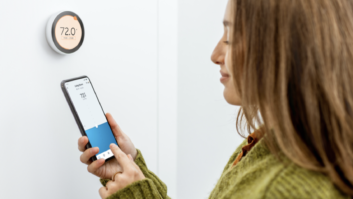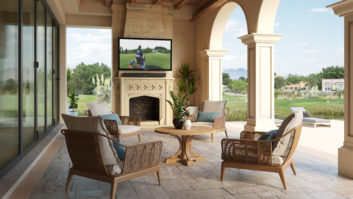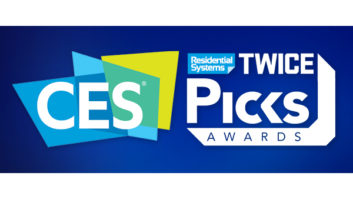SAN FRANCISCO — Last week Target launched its new Open House concept store here, an attempt to take the currently disparate parts of the world of the smart homes and home automation and try to make sense of them for the shopper. We were invited to preview the new store the day before it opened. One thing became very clear as we toured this new approach: Target has completely reimagined the retail experience for these types of products.
Upon entering the space, you are greeted with (of course) a house. But it’s not just a normal mockup you would expect to find in a bad department store furniture section, but beautifully laid out and … transparent? Yep, all the walls are clear acrylic, with stenciled Victorian designs on them as a nod to the local housing stock here in San Francisco.
The clear walls serve two purposes. First, they fade into the background to make the products the hero. A smart lock and smart front door camera pop out immediately as you first enter the room. The second purpose is to remove any distraction that a “designed” room might have triggered. Colored, walls, bright lights, or aggressive furniture could all have taken attention away from the experience. It’s the reason real estate agents have you paint all your colorful walls a neutral color before you put your house on the market.
“We landed here for many reasons, and it speaks openness, it has the wireframe quality to it, and the products pop in the space,” said Adam Laskowitz, Target senior experience designer. “We wanted in a sense to be material agnostic; we didn’t want the discussion to be, ‘I wouldn’t have that piece of furniture in my house, so let’s go to the next room.’ ”
The virtual house spans several rooms such as the living room, the bedroom and even the garage and garden. The entire back wall is an active screen, so as you approach a product, behind it appears a quote balloon with a description of that product. And this right here is where the real brilliance of the Target Open House finally appears. The hardest problem with this whole new market is it’s gigantic and yet formless at the same time. It’s the wild west of consumer electronics right now. Add in a shopping cart of standards such as IFTTT, Zigbee, ZWave and Apple HomeKit, and a normal consumer can’t tell one from another. Worse, they can’t visualize what their life could look like with all this fabulous technology.
No personal connection, no sale. That’s the problem facing this market right now. Now let’s go back to that quote balloon that Target cleverly placed on the wall right behind the product. First, it’s a quote, denoting a personality to these devices. And the fact that the graphic is fired as you approach means that there is a feeling the product is responding you, and more importantly, just you. Now that is a moment of personal connection.
That personal connection is reinforced with small kiosks with screens in the middle of each room. These are the glue that holds each of these spaces together, as they show how all these things become part of your life, and how they integrate with it. For instance, the living room kiosk has two buttons on it. “Coming Home” and “Leaving Home.” Press one and the active wall tells a story while the products in the room spring to life when you enter, and then all settle to await your return after. The experience brings the room to life, the technology now seamless with how you go about your day.
This effort to create a dialogue between the product and the customer continues throughout the store, and it shows how much Target realizes this is not a technology problem, it’s a conversation problem. When you approach the Apple-like product tables in another section of the Open House, they have informational monitors lying flat in front of each product. As you approach, once again they have proximity firing, the default screen icons flowing away from the edge of the screen as you approach. Then an information box appears in the middle. In another clever move, the description is not a boring statement such as “Security Camera.” Rather, the copy reads “I’m a smart security camera,” with that important first word again forging a connection and begging for further action from you.
These tables are actually more important for Target’s future than the virtual home, which can’t realistically be reproduced in all of its almost 2,000 stores nationwide. But the product tables have a very likely future in a store near you. So it’s important to realize that these interactive displays do one more important thing. Not only to they tell the same conversational stories that the kiosks do, but in addition they tell the integration story, maybe even better than the rooms do.
This is Target’s final assault on that first problem we brought up, the aforementioned shopping cart of acronyms and competing standards. As you read the story of each product, you notice the satellites of round icons surrounding it. These are the other products that the product you are looking at connects to. Sometimes they are from the same company, and often they are not. More importantly, you very quickly notice the products that don’t seem to play well with others. It’s noticeable in a way that a thousand articles on standards battles could never reveal. More importantly, it’s there right in front of the customer who is about to make a purchase decision.
This may the single most important dynamic that comes out of this experiment by Target. Because the Open House is so aggressively driven directly at the consumer, and not the industry, there is a clarity that has been missing until now. And it’s all about what these products can do to solve real problems in the real world of real consumers. And if your product can’t show that relationship, tell its story, and play well with everyone else, you may just find yourself as the dumbest product in the world’s smartest market.
Christopher Caen and Jamie Capozzi are principals of Theory Associates, a strategic branding agency based in San Francisco.













